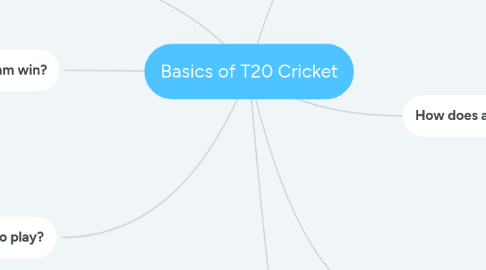
1. How is the pace of play structured?
1.1. A coin toss decides which team will "bowl" first and which team will "bat"
1.2. A match consists of 1 inning containing 20 "overs"
1.2.1. An over is a set of deliveries that a bowler bowls
1.2.1.1. An over is completed when a bowler has completed 6 successful legal deliveries
1.2.2. An inning can also be cut short if 10 batsmen are declared out
2. How does a team win?
2.1. Score more runs than the opposing team after each team has completed 20 overs
3. What do you need to play?
3.1. Cricket bat and ball
3.1.1. Similar to baseball, you can use a lighter bat or heavier bat
3.1.2. Leather ball is used in professional matches, however they are heavy and a tennis ball or rubber ball is suggested for beginners
3.2. Wickets
3.2.1. 3 "stumps" are used to form the wicket
3.2.2. 2 "bails" rest on the stumps.
3.3. Ground and pitch
3.3.1. The ground is the field where the game is played
3.3.1.1. The ground is spherical in shape
3.3.2. The pitch is located in the middle of the ground
3.3.2.1. Wickets are located on each end of the pitch
4. How many players are on a team?
4.1. There are 11 players on each team
4.1.1. Bowler - the player that "pitches" the ball to the batsman or batter
4.1.2. Batsman - the player that defends the wicket with a bat and attempts to score runs
4.1.3. Wicketkeeper - the fielder that stands behind the wicket (similar to a catcher in baseball)
4.1.4. Fielder - players on the bowling side that attempt to get the batsmen out
5. How does a team score?
5.1. Teams score runs which can be scored in a few ways
5.1.1. After a batsman hits the ball, the batter and their teammate run to separate sides of the pitch. Doing so successfully scores one run
5.1.1.1. Only a batter's bat must be in zone to be considered safe
5.1.1.2. The batter's partner waits in the "popping crease" behind the bowler until the batter has hit the ball
5.1.1.3. Batters do not HAVE to run when the ball is hit, but they will not score any runs by choosing not to run
5.1.2. If a batsman hits the ball and it bounces or rolls to the edge of the ground or outside of the ground, they automatically score 4 runs
5.1.3. If the batsman hits the ball out of the ground in the air, they automatically score 6 runs
6. Bowling
6.1. A bowler's job is to get wickets, meaning to get the batsman out which can be done in many different ways
6.1.1. One bowler will bowl 6 deliveries from one end of the pitch, then a teammate bowls 6 deliveries from the other end
